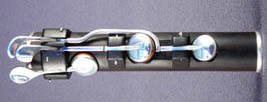|
The traditional C foot on the 8-key flute presents serious ergonomic challenges for the player. The reason is easy to demonstrate. Place your right hand fingers on the desk, spread widely as if covering the holes on an 8-key flute. Try moving your fourth finger from side to side. Not too bad. Now try moving it the other way. Result? Good mobility along the flute, very poor mobility across the flute. Unfortunately, this across-the-flute mobility is exactly what the traditional foot demands. Look at the Bilton flute foot below. The keytouches are set out as:
Moving from Eb to C# is OK, but getting to C natural is too much. Rotating the footjoint to bring C natural closer makes keeping your finger on Eb harder. Revised C Foot 1In my first Revised C Foot, I adopted this arrangement: The C and C# touches are interlocked in the usual way so that pressing the C touch automatically also closes the C# hole. The touch on the Eb key is also made concave rather than convex, in order to give more secure placement for the finger. It's also twisted a little to minimise any risk of pressing it while pressing either of the other two. Revised C foot 2Revised C Foot 2 adapts an idea Boehm used in his 1832 conical flute - moving the balance point for the C & C# touches further down the flute. This offers a better mechanical advantage and softer springing compared to crowding them all in above the Eb hole. There are some significant differences though:
One of the disadvantages remaining is that, like the traditional 8-key foot, the C and C# keys are articulated. Their junction can therefore be a source of movement and noise. Revised C Foot 3Boehm clearly recognised that as a problem and came up with the one-piece solution we are familiar with on the modern metal flute. Some later 8-key instruments adopted that layout but it has problems for the 8-key flute. Firstly, it normally assumes post-mounting, which is not to everybody's liking. Secondly, when your first three fingers are widely spread, it's more comfortable to have your fourth spread wide too (try it!). In the usual Boehm set-up, the fourth finger is held unnaturally close to the third when playing Eb. Revised C Foot 3 takes advantage of Boehm's idea, but attempts to deal with the remaining challenges: Features include:
Revised C Foot 4But still I'm not happy! And after much thinking about it, I know why. Even on an 8-key flute, playing C or C# comes up relatively rarely. It's the Eb key that we're supposed to be constantly pressing or not pressing, and so this is the key touch that needs to be the most accessible. And that's what's so irksome about the traditional arrangement - if you rotate the foot to make the C and C# accessible, the Eb is really uncomfortable. And so on to Revised C Foot 4, with increased emphasis on getting Eb just right. This took 6 months or more to come up with, but I think is the best by far. As you can see, it combines many of the features you've seen above, but again, with important variations. The Grasshopper's Knees keys for C and C# are back, but with a much better hinge point, and a ball joint at the knees, rather than the old flute's "finger through the hole" arrangement. Because the hinge point falls just where the Eb hole needs to be, we can't use the old flute's very simple longitudinal arrangement. Instead, we have a lateral arrangement, which acts more like an extension of the finger.
Summarising the features ... The Eb:
C and C#:
The whole arrangement being:
Future developmentsNo better ideas for the moment, but if they occur, I'll present them here as they come along! |

